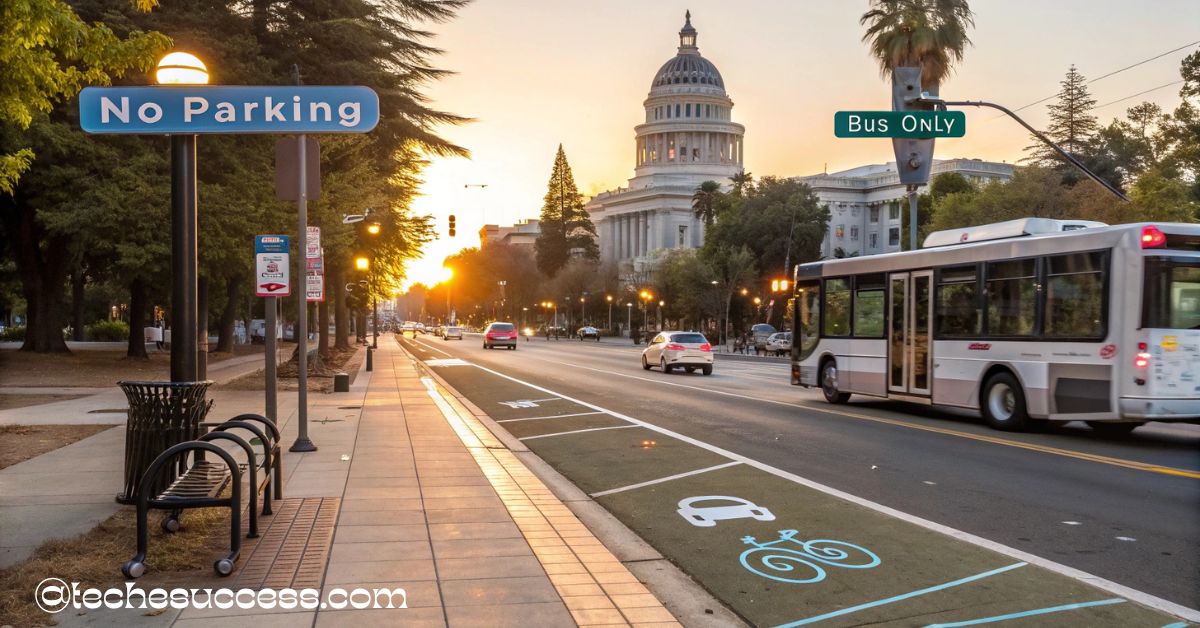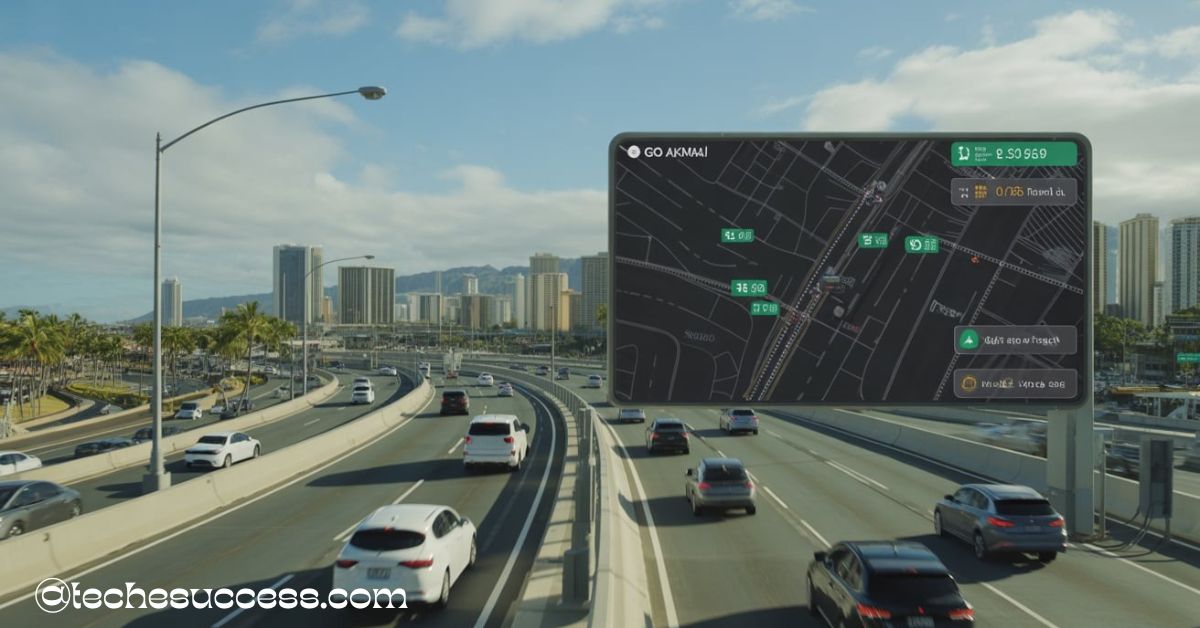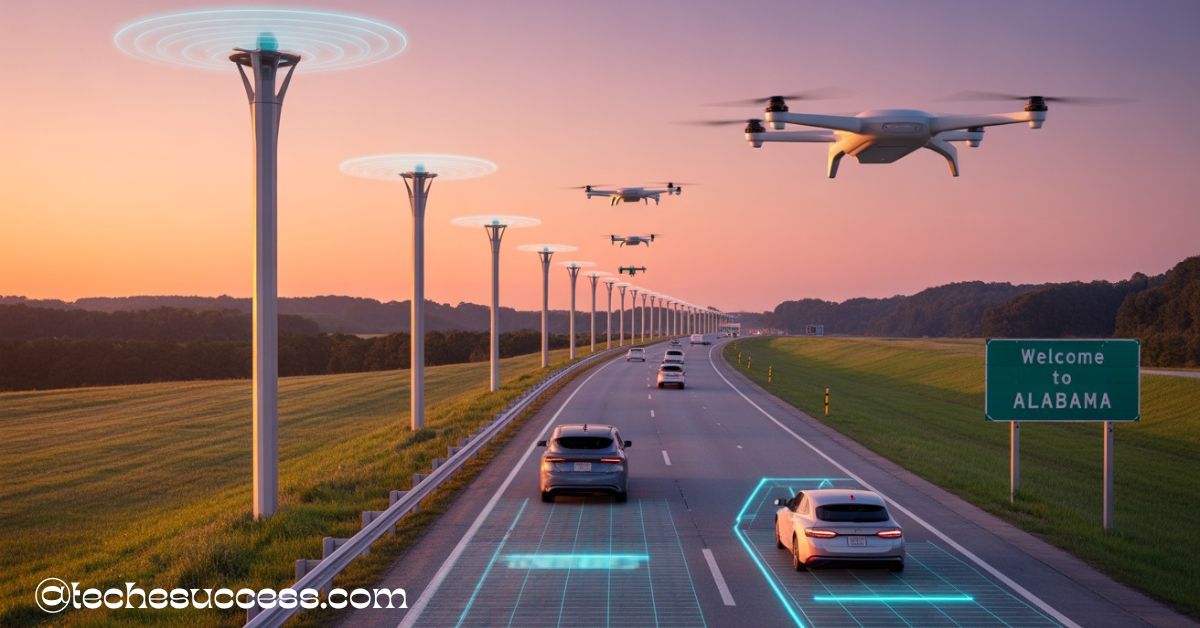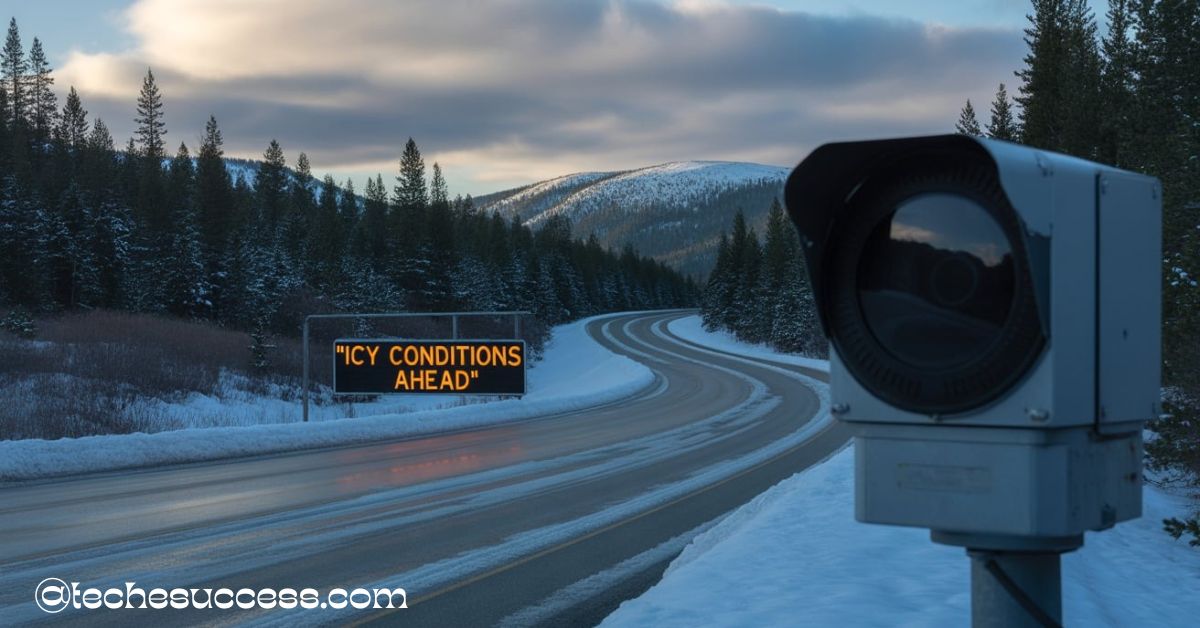Sacramento parking AI surveillance cameras are smart systems installed on city buses to detect illegal parking in bus stops and bike lanes. They enhance safety, accessibility, and traffic efficiency by capturing real-time violations. This AI-powered solution ensures fair enforcement while supporting California’s smart city goals.
“Stay tuned with us as we continue to explore everything you need to know about Sacramento parking AI surveillance cameras—from how they work to their impact on city safety and traffic enforcement.”
Legal Basis: AB 917 & AB 361
The foundation of Sacramento’s AI surveillance initiative lies in two key California legislative bills—Assembly Bill 917 (AB 917) and Assembly Bill 361 (AB 361). These laws authorize transit agencies to equip their buses with automated enforcement technology to capture illegal parking incidents, especially in bus zones and bike lanes.
AB 917, signed into law in 2021, permits transit agencies across California to use cameras on buses to document violations at transit stops. It was introduced to solve the problem of vehicles obstructing buses, which often delays public transit schedules and compromises safety. This bill ensures that cameras can record evidence, but actual citation issuance must still go through human verification, balancing technology with civil rights.
Following AB 917, AB 361 expanded the initiative’s scope to include the enforcement of bike lane violations. As urban cycling becomes more prevalent, ensuring bike lanes remain free of obstructions is essential. This legal expansion demonstrates the state’s commitment to safer, more efficient multimodal transportation.
The initiative also aligns with California’s new daylighting law bans parking near intersections for pedestrian safety, helping improve line-of-sight for both drivers and pedestrians. This law, designed to reduce traffic collisions, complements Sacramento’s efforts in reimagining urban safety.
Both bills stipulate a due process framework—warning periods before full enforcement, public notification, signage requirements, and opportunities for vehicle owners to dispute citations. Together, they form the backbone of Sacramento’s authority to roll out its parking AI surveillance camera program legally and responsibly.
The AI Camera System: Hayden AI & Duncan Solutions
At the heart of Sacramento’s enforcement solution are the Hayden AI surveillance systems. These state-of-the-art cameras are mounted on the front of SacRT buses and designed specifically for transit and bike lane enforcement. Equipped with high-definition lenses and advanced machine learning algorithms, the cameras can detect vehicles illegally parked in restricted zones with precision.
These AI-powered systems don’t merely take snapshots—they collect comprehensive data, including timestamped video, GPS coordinates, and vehicle license plate numbers. This detailed metadata ensures that violations are accurately documented and verifiable. It allows enforcement officials to make informed decisions when issuing citations.
Once a potential infraction is detected, the footage and data are transmitted securely to Duncan Solutions, a third-party vendor that assists the city with violation review and citation processing. Importantly, no automated fines are issued without a manual human review, maintaining fairness and accountability.
Users can also access real-time enforcement updates via the Sacramento parking AI surveillance cameras app, which increases public engagement and transparency. This tool helps drivers verify zones under surveillance, promoting compliance through education.
The technology has proven effective even under varied weather and lighting conditions, making it a reliable year-round enforcement tool. It also alleviates the burden on overstretched traffic officers, enabling real-time enforcement across more locations than previously possible.
Deployment Timeline: Pilot, Warnings, Citations, Bike Lane Phase
Sacramento’s roll-out of parking AI surveillance cameras followed a carefully planned, phased approach to ensure public transparency and effective system calibration.
The initial pilot phase began in late 2024, with Hayden AI systems installed on a limited number of buses. Over the 70-day test period, the system detected more than 280 violations at bus stops. Encouraged by these results, the city expanded its implementation.
A 60-day warning period commenced in December 2024, during which violators received notices but were not fined. This educational period allowed the public to become familiar with the new enforcement tool. Nearly 2,740 warning notices were issued during this phase—highlighting the scale of the problem and the system’s effectiveness.
On February 18, 2025, the city began issuing actual citations for bus stop violations, each carrying a $100 fine. This marked the start of full-scale enforcement, with daily reviews by trained city officials.
In spring 2025, the program expanded to include bike lane enforcement. A second warning period ran from April 14 to June 12, followed by active citations beginning June 13, 2025. These new phases further extended the AI system’s capabilities and coverage across the city.
For residents and policymakers, understanding the Sacramento parking AI surveillance cameras cost was essential in evaluating its value. While initial setup and vendor services required investment, the long-term savings in enforcement resources and public safety benefits offer a strong return on investment.
Enforcement Focus: Bus Stops & Bike Lanes
The AI surveillance system primarily targets two high-risk zones: bus stops and bike lanes. These areas are often obstructed by illegally parked vehicles, creating significant safety hazards and delays.
Bus Stops
When a vehicle blocks a bus stop, it forces buses to either stop in traffic lanes or skip the stop entirely—impacting riders, especially seniors and people with disabilities. The AI cameras identify such violations in real time, capturing the scene and sending the data for review. This ensures that bus access points remain clear and functional.
Bike Lanes
Illegally parked vehicles in bike lanes force cyclists to merge into traffic, increasing the risk of accidents. With AB 361’s passage, Sacramento empowered its buses to monitor bike lane obstructions. The AI system scans designated bike lanes and flags vehicles that encroach upon them.
In addition to these zones, the system helps enforce ‘daylighting’ parking rules. This involves keeping corners and intersections clear to improve visibility—a key factor in pedestrian safety. AI systems can detect and report violations tied to ‘daylighting’ parking enforcement, further aligning with state laws and local safety initiatives.
This targeted enforcement strikes a balance between efficiency and fairness, focusing resources on violations that impact the most vulnerable road users.
Benefits: Safety, Accessibility, Efficiency
The adoption of Sacramento parking AI surveillance cameras is driven by clear, tangible benefits—especially in the areas of public safety, accessibility, and citywide efficiency.
Enhanced Safety
Keeping bus stops and bike lanes clear improves safety for everyone. Riders can board and exit buses without stepping into traffic, and cyclists no longer need to swerve into car lanes. This is especially critical for people with disabilities, seniors, and parents with strollers.
The system also helps enforce California’s new daylighting law bans parking near intersections for pedestrian safety, ensuring better visibility at corners and reducing collision risks.
Improved Accessibility
The system supports Sacramento’s equity goals by ensuring reliable transit access for all neighborhoods. When bus stops are unobstructed, service becomes more dependable and inclusive. This boosts ridership and reduces transit delays.
Operational Efficiency
AI surveillance removes the need for constant manual patrols, freeing up city resources. Buses equipped with cameras serve as mobile enforcement units, providing broad coverage with minimal staffing. As a result, Sacramento can enforce rules more consistently and fairly across the city.
These benefits align closely with broader smart city initiatives, making Sacramento a model for other urban centers looking to modernize enforcement.
Early Results: Violation Numbers and Impact
Since implementation, the results of Sacramento’s AI surveillance program have been compelling. During the pilot phase, buses equipped with Hayden AI systems recorded over 280 violations in just 70 days at bus stops alone. This early data indicated a widespread issue with illegal parking that had gone largely unchecked due to limited enforcement resources.
During the 60-day warning phase beginning December 2024, nearly 2,740 warning notices were issued to drivers. These figures illustrate how often vehicles were obstructing essential public infrastructure, validating the need for technological intervention.
Once full enforcement began in February 2025, daily violations initially remained high, but gradually declined as drivers adjusted to the new system. In the bike lane phase, more than 300 violations were recorded within the first few weeks, reinforcing the scale of the challenge in ensuring bike safety.
These early outcomes reflect not only the system’s efficacy in identifying violations but also its influence in changing driver behavior. As awareness grows, compliance is expected to improve further, amplifying the program’s benefits over time.
Public Feedback: Support, Criticism, and Concerns
As with any innovative public policy, Sacramento’s surveillance initiative has drawn a range of responses from residents, stakeholders, and advocacy groups.
Public Support
Many transit riders and safety advocates have welcomed the initiative. The increased clarity at bus stops and enhanced bike lane access has made daily commutes safer and more predictable. Advocacy groups for the disabled have also voiced support, noting the program’s role in protecting ADA-compliant access.
Concerns & Criticism
However, concerns persist. Some residents have criticized the lack of clear signage in certain enforcement areas, particularly around driveways and curb cuts. One notable case involved a driver receiving $450 in fines over multiple days due to unclear markings—raising concerns about fairness.
Privacy advocates have also questioned the constant recording by public buses, even though footage is reviewed manually and used solely for enforcement. The city has responded by committing to transparent data handling practices and public accountability.
In balancing support with legitimate concerns, Sacramento has pledged to fine-tune the program, improve signage, and educate the public.
How It Works: From Detection to Ticket
Understanding how Sacramento’s parking AI surveillance cameras work helps clarify both their value and limitations. The enforcement process is structured and transparent, ensuring due process and accountability.
- Bus approaches zone → AI detects potential violation
- Camera records video, license plate, location, and time
- Data sent securely to Duncan Solutions
- City official manually reviews flagged footage
- If validated, citation is mailed with dispute instructions
- Drivers may appeal the citation via the city’s portal
This hybrid system, blending AI efficiency with human oversight, ensures fairness while optimizing enforcement capabilities.
Weighing the Outcomes: Pros vs. Cons
| Pros | Cons |
| Enhances public safety | Possibility of false positives |
| Reduces bus delays and traffic congestion | Concerns about signage clarity |
| Promotes accessible public transport | Questions around privacy and surveillance |
| Increases enforcement efficiency | Public resistance in high-fine zones |
| Improves bike lane usability | Costs of system maintenance and operation |
Challenges & Missteps: Signage, Fairness, False Positives
Despite overall success, the program has encountered notable hurdles. One of the most cited issues is inadequate signage in some enforcement zones. When curb markings fade or signs are unclear, drivers may inadvertently park in restricted areas.
There have also been reports of false positives, where AI cameras flag vehicles that aren’t actually in violation. In some cases, vehicles parked near driveways or temporarily idling were cited—raising concerns about algorithmic sensitivity.
Sacramento has addressed these issues by committing to improved signage, clearer curb markings, and continued refinement of the detection software. Public education campaigns are also being rolled out to inform residents about enforcement boundaries and dispute mechanisms.
While no system is perfect, these early challenges highlight the importance of transparent policy and agile adaptation.
Future Outlook: Expansion and Broader Trends
Looking ahead, Sacramento’s success with AI surveillance cameras is likely to influence other cities exploring tech-driven enforcement. Already, cities like Los Angeles and San Francisco are evaluating similar systems.
Locally, Sacramento plans to expand the program beyond current routes, possibly including school zones, loading zones, and pedestrian crossings. With system performance improving over time, new capabilities like real-time violation alerts and AI-powered analytics could further optimize urban traffic management.
As technology matures, these smart enforcement tools will play a central role in building safer, smarter, and more efficient cities.
Conclusion & Recommendations
Sacramento’s deployment of AI surveillance cameras for parking enforcement is a bold step toward modern urban management. By combining cutting-edge technology with thoughtful legislation, the city has improved public safety, accessibility, and transportation reliability.
While the program isn’t without challenges, its benefits far outweigh the drawbacks. With continued transparency, system refinements, and public education, Sacramento can set a lasting example for cities nationwide.
Frequently Asked Questions (FAQs)
1. Are Sacramento parking AI surveillance cameras active all the time?
Yes, the cameras are operational whenever the buses are in service, capturing violations in real time.
2. Can I dispute a citation from an AI camera?
Absolutely. All citations undergo human review and come with instructions for disputing the charge if you believe it was issued in error.
3. Are the cameras invading driver privacy?
No. The cameras are focused on public areas and are used solely for traffic enforcement. All data is handled under strict guidelines.
4. How much is the fine for a parking violation?
The standard citation for illegal parking in a bus stop or bike lane is $100.
5. Will the AI system expand to other areas in Sacramento?
Yes. Future phases may include enforcement in school zones and other high-priority areas.
Also Read:













Leave a Reply